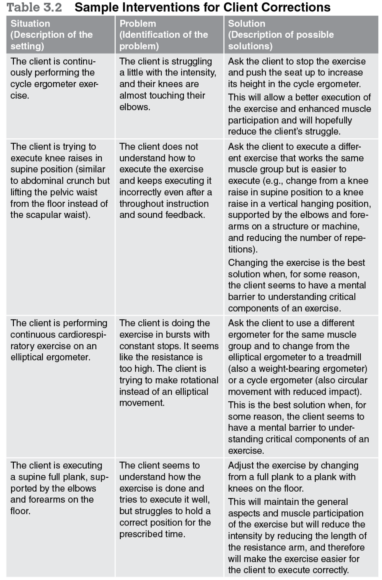Execution of Exercises
This is an excerpt from EuropeActive's Essentials for Personal Trainers by .
One of the most important interventions is related to how an exercise is performed. The personal trainer must be able to intervene to help the client demonstrate safe and effective exercise technique. Interventions include good instruction, demonstration and explanation of the critical components of each exercise, and proficiency in identifying the client's execution errors, correcting those mistakes in execution and adjusting exercises when needed.
A good instruction is usually a short communication where the personal trainer focuses on the most important aspects of the exercise that will guarantee that the client can start the exercise without serious errors, particularly those that could threaten their safety. Many times this includes a demonstration of the exercise by the personal trainer so that the client will have a visual image of what is intended. The content (information) of the instruction and the way of saying it (rehearsal effect) can be practised so that the personal trainer will come across as secure, experienced and proficient and will effectively convey the message.
The personal trainer must be able to identify and correct any exercise execution errors, bad posture or mistakes that the client may engage in right when they occur. Both capacities are crucial. Identifying errors is probably the hardest skill, especially for novice personal trainers, but it becomes easier with experience. Correcting errors properly, giving appropriate feedback and using the right correction techniques to solve the problem are also very important.
Sometimes to make an exercise appropriate for a particular client the personal trainer must adjust the exercise. This includes changing exercise prescription components, modifying exercises and sometimes substituting one exercise for another.
Table 3.2 describes different types of interventions. These may include simple feedback or more intensive interventions, such as asking the client to stop the exercise so that the personal trainer can give a demonstration or additional explanation. Personal trainers should carefully consider the type of intervention needed for a given situation before making it. If the personal trainer gives only feedback, the client may receive this as a normal intervention. But if the personal trainer asks the client to stop the exercise, they may perceive this as failure, which will probably make them feel bad about the training session. It is the personal trainer's job to counteract such feelings by using good communication, assuming a pedagogic attitude, explaining to the client what is happening at all times and paying special attention to the motivational aspects of the communication with the client. As a rule personal trainers should interrupt an exercise only when the identified errors relate to safety issues. If the physical integrity of the client is not at stake, most of the times there is no reason to interrupt the exercise.

Safety
Another main task of the personal trainer is to promote the highest safety standards during the preparation of the exercise programme (based on a sound assessment of the client's medical history, lifestyle and fitness) and throughout all training sessions. Exercise does involve some risks, particularly in clients with chronic conditions and when appropriate assessment is not considered and proper exercise prescription guidelines are not followed (CSEP 2010; Thompson 2013). However as a general rule moderate exercise is very safe, and provides health benefits even for sedentary, higher risk populations (Clark et al. 2005).
Clients may encounter two main types of risks related to exercise: orthopaedic risk and metabolic risk. Orthopaedic risk is mainly related to the technical execution of the exercises and postures, and may result in joint and muscle injuries. It can be prevented with a good selection of exercises and effective correction of execution errors and bad posture. Metabolic risk is mainly related to exercise intensity and to the client's particular characteristics, including undiagnosed health problems that may lead to abnormal responses to exercise such as sudden drops in blood pressure, myocardial infarction or stroke. Sound guidelines for assessing the client and defining the specific dimension of the metabolic challenge to be imposed can be easily found in publications in the field (ACSM 2013; CSEP 2010).
Metabolic risk can be decreased by assessing the client's response to exercise using available strategies. For example during continuous cardiorespiratory exercise, the personal trainer can use a heart rate monitor to verify if the client is in the predetermined target zone. They can also use the talk test (Persinger et al. 2004), asking the client to speak a few words in a row. If the client has a hard time speaking more than a few words without getting out of breath, the exercise intensity may be too high. In other forms of exercise the personal trainer should maintain good communication with the client to assess whether they feel well and comfortable; for example the rating of perceived exertion (RPE) scale - also called the Borg scale - can be used (Irving et al. 2006; von Leupoldt et al. 2006).
The bottom line is that the personal trainer is responsible for assuring a healthy and safe exercise during all training sessions and workouts, following clients, identifying dangerous situations and intervening accordingly.
SHOP

Get the latest insights with regular newsletters, plus periodic product information and special insider offers.
JOIN NOW
Latest Posts
- Using double inclinometers to assess cervical flexion
- Trunk flexion manual muscle testing
- Using a goniometer to assess shoulder horizontal adduction
- Assessing shoulder flexion with manual muscle testing
- Sample mental health lesson plan of a skills-based approach
- Sample assessment worksheet for the skill of accessing valid and reliable resources


